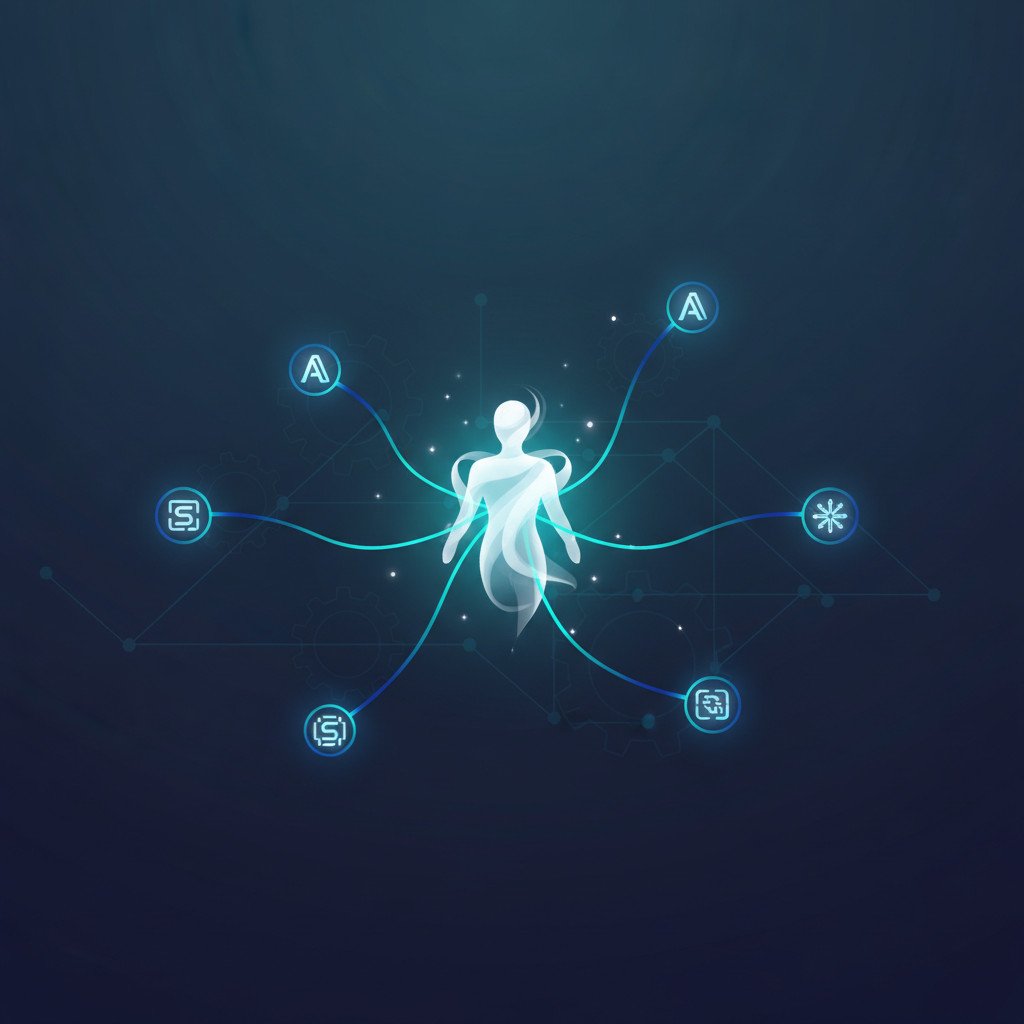What is Agentic AI? Exploring the Future of Autonomous AI Systems
Agentic AI is a leap beyond reactive models; it lets systems set goals and pursue them autonomously. Because these agents plan, decide, and act, they reshape how work flows across systems and teams. For enterprises, this change promises faster outcomes and scaled problem solving. However, it also brings new governance, orchestration, and data quality demands.
Picture software that coordinates tasks, calls APIs, and learns from outcomes. As a result, mundane bottlenecks vanish and human roles become strategic. Yet without clear policies and robust logging, confidence quickly erodes.
This is why non-AI foundations matter as much as model performance. Therefore, orchestration, role-based access, and compliance checkpoints must guide deployments. In practice, these components turn experiments into measurable ROI.
In the sections that follow, we explore agentic orchestration, governance, and change management. You will find practical steps, real enterprise concerns, and design patterns. By the end, you will understand how to build reliable, auditable autonomous systems.

What is agentic AI?
Agentic AI describes systems that set goals, plan actions, and execute tasks with minimal human prompting. In practice, these intelligent agents act across systems. They coordinate APIs, update records, and learn from outcomes. As a result, agentic AI brings true AI autonomy to workflows. Because these agents can decide and act, they change how teams work.
Agentic AI overlaps with autonomous AI and intelligent agents. However, it emphasizes ongoing orchestration and governance. Therefore, it focuses on safe, auditable actions. Moreover, agentic AI relies on clean data and clear role permissions. Without those foundations, results become unreliable.
How agentic AI works: autonomous AI and intelligent agents
Core components include planning, sensing, and execution. A planner sets objectives. A sensor layer gathers context. An executor calls APIs and updates systems. Together, these parts form an agent loop. In practice, agents monitor outcomes and adapt. Consequently, they reduce manual handoffs and speed decisions.
Key design elements
- Goal driven behavior that maps to business outcomes
- Orchestration to sequence multi-step tasks
- Human-in-the-loop checkpoints for risky decisions
- Logging and RBAC for traceability and compliance
- Data quality measures to reduce error rates
Practical enterprise examples
- Customer triage agent: A support agent reads tickets, categorizes issues, and assigns owners. If needed, it escalates to humans. This reduces response time and improves case routing.
- Invoice processing: An agent combines IDP with agentic automation to validate invoices and trigger payments. For more on enterprise implementation patterns see Enterprise Implementation Patterns.
- Go-to-market orchestration: Sales agents coordinate lead scoring, outreach, and handoffs. They speed pipeline motion and maintain audit logs. Learn how agentic platforms accelerate timelines at Agentic Platforms.
- Infrastructure scaling: Agents manage cloud resources and deployments. They follow policies and compliance checks. For guidance on building enterprise AI infrastructure see Enterprise AI Infrastructure.
In short, agentic AI combines autonomy, orchestration, and governance. Thus, it can transform operations when supported by non-AI foundations like governance, clean data, and orchestration.
| Aspect | Agentic AI | Traditional AI systems |
|---|---|---|
| Autonomy level | High. Agents set goals and act across systems. | Low to medium. Models mostly respond to prompts or predictions. |
| Decision making | Proactive multi-step decisions with planning and execution. | Reactive outputs or single-step predictions. |
| Adaptability | Learns from outcome feedback and adapts over time. | Adapts slowly; requires retraining or manual tuning. |
| Typical use cases | Orchestration, workflow automation, incident remediation, complex task chains. | Classification, prediction, recommendation, single-task automation. |
| Human role | Supervisory with human-in-the-loop checkpoints for risky actions. | Operator or end user interpreting model outputs. |
| Governance and auditability | Built for logging, RBAC, and traceable decision trails. | Often lacks end-to-end action logs and role controls. |
| Orchestration and integration | Coordinates APIs, services, and systems end-to-end. | Integrates at point solutions; needs external orchestration. |
| Data requirements | High-quality, governed data for reliable actions. | Data quality matters but models tolerate noisy inputs. |
| Error handling | Detects failures, retries, and escalates to humans. | Fails silently or needs manual intervention to correct. |
| Benefits | Faster workflows, reduced manual handoffs, scalable problem solving. | Simpler deployment and predictable outputs for narrow tasks. |
| Risks and challenges | Requires governance, orchestration, and clear policies. | Risk of misinterpretation and brittle behavior outside scope. |
Benefits and Challenges of agentic AI
Agentic AI promises substantial gains for organizations. It speeds decisions, reduces manual steps, and scales complex workflows. As a result, teams can focus on strategic work. However, the technology also brings new responsibilities around safety and oversight.
Key benefits
- Faster outcomes and reduced cycle times. Agents orchestrate tasks across systems and close loops automatically. This lowers time to resolution in support and operations.
- Scalable problem solving. Because agents plan and act, they handle multi-step processes at scale. Consequently, enterprises can automate end-to-end workflows.
- Improved consistency and traceability. When agents log actions, audit trails improve compliance and debugging.
- Enhanced productivity and AI innovation. Teams pair human judgment with agentic autonomy to unlock fresh use cases.
In practice, an often-repeated truth applies: “An AI agent is only as good as the data it runs on.” Therefore, cleaner data yields fewer errors and higher trust. Also, “Agentic orchestration is the connective tissue.” That is why orchestration, RBAC, and logging matter.
Major challenges and risks
- Governance and AI ethics. Agents make decisions with real impact, so policies must define scope and limits. For strategic guidance on management changes, see MIT Sloan.
- AI risk management. Systems need automated checks, escalation paths, and rollback plans. As a result, failure modes become manageable rather than catastrophic.
- Data and integration debt. Most enterprise processes were not built for agents. Therefore, integration work can dominate projects.
- Human trust and change management. Training and clear interfaces matter to drive adoption.
Experts and practitioners emphasize governance frameworks. For practical governance frameworks, IBM provides a useful guide. The International Association of Privacy Professionals highlights emerging regulatory concerns at IAPP.
Across sectors, agentic AI can transform work. In healthcare, agents could triage cases and surface anomalies. In finance, they can automate reconciliation and compliance checks. In manufacturing, agents could remediate incidents and optimize workflows. However, each sector needs tailored risk controls and strong data practices.
Conclusion
Agentic AI is not a distant idea; it is a practical shift in how software acts, learns, and scales. As a result, organizations can automate end-to-end workflows and free human teams for strategic work. However, realizing this promise requires strong foundations: governance, orchestration, data quality, and change management. Without them, experiments rarely translate into measurable impact.
EMP0 leads this transition with a full-stack approach to AI and automation. Their Content Engine, Marketing Funnel, and Sales Automation tools integrate into enterprise systems. Moreover, EMP0 positions itself as a full-stack AI worker provider that helps clients multiply revenue through AI-powered growth systems. These solutions deploy securely under client infrastructure and follow governance and RBAC best practices.
Because EMP0 combines orchestration, logging, and role-based controls, teams gain faster outcomes and auditable workflows. In practice, this reduces integration risk and accelerates ROI. Therefore, companies that pair agentic AI with the right non-AI foundations will outpace competitors.
To learn more, visit EMP0’s website or blog, or explore their creator page for integrations:
In short, agentic AI unlocks new operational possibilities. With the right governance and partners like EMP0, businesses can scale safely and confidently into an autonomous future.
What is agentic AI?
Agentic AI refers to systems that set goals, plan, and act with limited human prompts. These intelligent agents coordinate tasks across systems. As a result, they deliver AI autonomy across workflows. They learn from outcomes and adapt behavior over time.
How does agentic AI differ from traditional AI?
Traditional AI usually returns a prediction or a classification. By contrast, agentic AI takes multi-step actions to reach objectives. Therefore, it needs orchestration, logging, and governance to operate safely. As a result, agentic systems often integrate deeply with enterprise processes.
Where is agentic AI most useful?
- Customer support triage and routing
- Invoice validation and payments automation
- Sales orchestration and lead handoffs
- Cloud scaling and incident remediation
Each example ties agentic autonomy to measurable outcomes.
What benefits can organizations expect?
- Faster cycle times and reduced manual handoffs
- Scalable end-to-end automation for complex tasks
- Better audit trails through automated logging
- Increased productivity and AI innovation in teams
These benefits depend heavily on data quality and orchestration.
What are the main challenges and risks?
- Governance and AI ethics for decision scope
- AI risk management including rollback plans
- Integration debt from legacy systems
- Human trust and change management hurdles
Without controls, experiments rarely become measurable ROI.
How can enterprises prepare for agentic AI?
- Invest in clean, governed data
- Build agentic orchestration and RBAC controls
- Automate logging and compliance checkpoints
- Train teams to supervise agents and handle escalations
What does the future hold for agentic AI?
Agentic AI will expand practical automation across sectors. However, adoption will favour organizations that pair autonomy with governance. Consequently, firms that build those non-AI foundations will scale safely and gain advantage.

